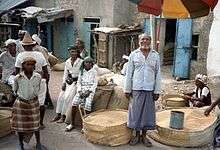Izaar

An izaar (Arabic: إزار),[1] futah فوطة),[2][3][4][5] ma'awaz (معوز),[6][7][8][9] wizara (وزرة),[10][11] magtab or maqtab (مقطب)[12][13][14][15] is a lower garment typically worn by men in the Arabian Peninsula, notably in countries like the United Arab Emirates, Oman, Yemen, Bahrain, Saudi Arabia and Qatar, and the Horn of Africa (Somalia, Djibouti and Eritrea). It is also worn in Muslim countries such as Indonesia, Malaysia, Bangladesh, Pakistan and countries in some parts of East Africa and in India among Muslims. It is also commonly worn by some Arabs at home.[16] In some parts of Arabia such as Yemen and the Jizan and ʿAsir regions of Saudi Arabia, it is known as futah instead. Some of these may feature tassels.
Similar garments
The izaar may be considered synonymous with the lungi in the Indian subcontinent and with the macawiis in the Horn of Africa. It may also be considered a type of sarong (spelt saroun صارون in Arabic).
It is similar to a kilt, except it is lighter and thinner. It is usually striped or patterned with bold colours (often with rectangular shapes), but it can also be found plain. An izaar is usually folded around the lower body, then wrapped tightly around the waist.
See also
References
- ↑ http://journals.yu.edu.jo/jja/JJAIssues/Vol3No1_2010PDF/06.pdf
- ↑ http://journals.yu.edu.jo/jja/JJAIssues/Vol3No1_2010PDF/06.pdf
- ↑ http://nationalclothing.org/41-nationalclothing/middle-east/yemen/58-yemeni-traditional-dress-yemen-is-a-country-with-a-remarkably-diverse-fashion.html
- ↑ http://www.britannica.com/topic/futah
- ↑ Marshall Cavendish (1 September 2006). World and Its Peoples. Marshall Cavendish. pp. 142–. ISBN 978-0-7614-7571-2.
- ↑ http://www.26sep.net/newsweekarticle.php?sid=7030
- ↑ http://journals.yu.edu.jo/jja/JJAIssues/Vol3No1_2010PDF/06.pdf
- ↑ http://www.taizgov.com/new/component/content/article.html?id=216
- ↑ http://14october.com/news.aspx?newsno=140758
- ↑ http://worldtravelbuzz.com/exploring-saudi-arabia-tihama-faifa/
- ↑ http://chrisspivey.org/the-sunday-spiv-010215/
- ↑ http://www.26sep.net/newsweekarticle.php?sid=7030
- ↑ Moshe Piamenta (1991). Dictionary of Post-Classical Yemeni Arabic Part: 2. BRILL. pp. 404–. ISBN 90-04-09293-5.
- ↑ http://smallwarsjournal.com/sites/default/files/839-spencer.pdf
- ↑ http://www.taizgov.com/new/component/content/article.html?id=216
- ↑ ICharacter and Morals By Muhammad Saed Abdul-Rahman